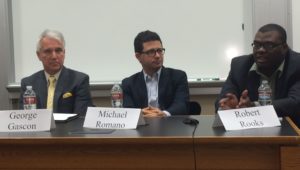Proposition 47’s Successful Implementation Depends on New Alliances, Say Prison Reformers
“Now the real work begins,” said Michael Romano, director of Stanford’s Three Strikes Project at a forum on California’s recent prison reform initiatives held Tuesday at Stanford Law School. Others on the panel were George Gascon, district attorney for San Francisco and Robert Rooks, organizing director of Proposition 47 and Californians for Safety and Justice.

From left, panelists George Gascon, district attorney for San Francisco; Michael Romano, director of Stanfords Three Strikes Project; and Robert Rooks, organizing director of Proposition 47 and Californians for Safety and Justice at a forum held at Stanford Law School.
Romano was referring to the recent passage of Proposition 47, which reduces penalties for many nonviolent offenses in California, such as drug possession and petty theft crimes, from felonies to misdemeanors. In order to be successful, Romano argued, the new law is going to require progressive organizations that favor the law to work together with law enforcement leaders who, for the most part, fought Proposition 47. The end result could be a reduction not only in incarceration but also in recidivism and, therefore, in crime, as more former inmates turn their lives around with help from churches, job training, drug rehabilitation programs and community organizations.
“Lawyers who think their only goal is to get clients out of jail are going to have to think more as problem solvers,” said Gascon. He was one of only a few law enforcement leaders who worked for the passage of both propositions. He noted that the ballot victories show the public supports measures that create “more sustainable safety models.”
Like Proposition 36, an initiative that California voters approved in 2000 that modified the state’s “Three Strikes” law, Proposition 47 won traction from voters who believe in giving people second chances, he explained.
“Law enforcement leaders and elected officials are way behind the voters on these issues,” Romano said.
Rooks credited an unusual alliance of labor leaders, Catholic church bishops and “door knockers” who cared about progressive legal issues for the successful passage of Proposition 47. “We were able to bring networks of people together who had never worked together before,” he explained.
The ramifications of Proposition 47 are enormous. Rooks notes that San Diego County alone identified 200,000 people who might be able to change their record from a felony to a misdemeanor, based on the new law. He said his organization, Californians for Safety and Justice, will be working with legal clinics and community groups across the state to help deal with the anticipated flood of requests.
Gascon’s Public Defender’s Office in San Francisco has already set up an information line to assist former clients and others seeking relief under the new law at (415) 553-9344.
Proposition 47 calls for the money saved from incarcerating fewer people to be used for a “Safe Neighborhoods and Schools Fund,” for truancy and drop-out prevention programs in schools, victims’ services, and mental health and drug treatment programs designed to keep individuals out of the criminal justice system. Rooks said that funding – an estimated $200 million to $250 million per year –
will become available in early 2016, as the measure calls for a full year of baseline data to be collected first.
While there has been much talk about savings at the state level, Gascon pointed out that cities and counties also will benefit from reduced costs in prosecution and police services. “The question is, are local governments going to shift the money and do the right things?” he said.
The three panelists agreed that prison reformers in other parts of the U.S. are following California’s efforts with interest. They are learning, Romano, said, that “the people really want this.”
